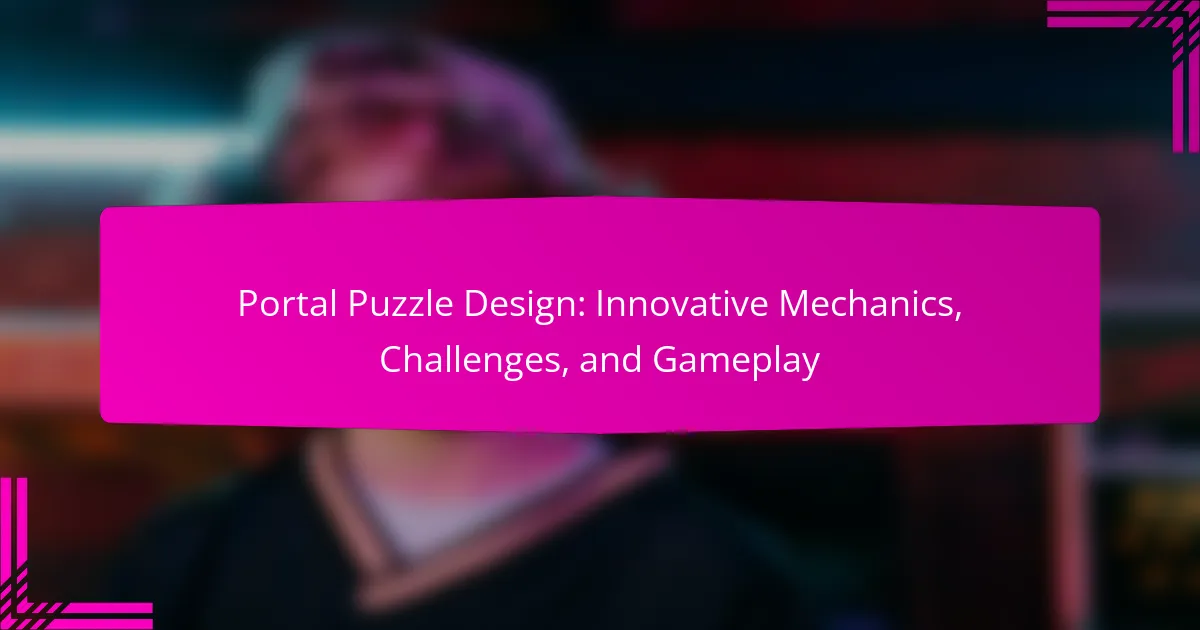Portal puzzle design captivates players by challenging their critical thinking and problem-solving skills. This article explores innovative mechanics, engaging challenges, and effective gameplay strategies. It highlights the importance of player feedback, narrative integration, and balancing complexity with clarity. Additionally, it discusses unique attributes that elevate the puzzle-solving experience, ensuring sustained player engagement.

What are the fundamental mechanics of portal puzzle design?
Portal puzzle design revolves around innovative mechanics that challenge players to think critically. Key mechanics include spatial manipulation, physics-based interactions, and the use of portals to create shortcuts or alter environments.
Players face challenges such as timing, resource management, and puzzle complexity. Effective gameplay relies on intuitive controls and clear visual cues, enhancing player engagement.
Unique attributes of portal puzzles often involve multi-dimensional thinking and the ability to solve problems from various angles. Rarely, puzzles may introduce unexpected mechanics that surprise players, deepening the experience.
Overall, successful portal puzzle design combines creativity, logic, and player feedback to create compelling gameplay.
How do portals alter spatial dynamics in gameplay?
Portals significantly alter spatial dynamics in gameplay by enabling players to traverse distances instantly. This mechanic creates unique puzzle-solving opportunities and challenges, enhancing player engagement. Portals allow for innovative interactions, such as redirecting projectiles or manipulating enemy movements. They can also introduce complex spatial reasoning, requiring players to think in three dimensions. The use of portals often results in non-linear gameplay, encouraging exploration and experimentation.
What role do physics play in portal mechanics?
Physics plays a crucial role in portal mechanics by defining how portals interact with space and time. The principles of momentum, gravity, and energy conservation govern the behavior of objects as they pass through portals. For example, when an object enters a portal, its velocity and direction are maintained, allowing for innovative puzzle designs. Additionally, the manipulation of spatial dimensions creates unique gameplay challenges, requiring players to think critically about physics concepts. Understanding these mechanics enhances the immersive experience and strategic depth of portal-based puzzles.
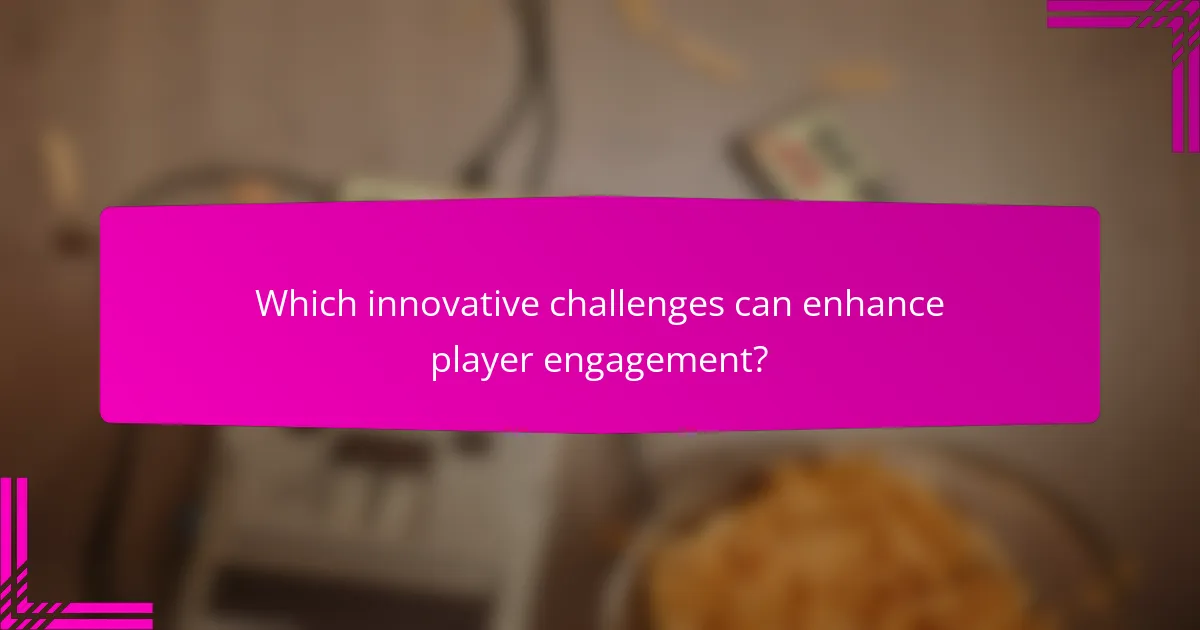
Which innovative challenges can enhance player engagement?
Innovative challenges in portal puzzle design can significantly enhance player engagement. Incorporating mechanics like time manipulation, environmental interaction, and multi-dimensional puzzles captivates players by offering unique problem-solving experiences.
Players enjoy challenges that require creative thinking and collaboration. Introducing cooperative puzzles that necessitate teamwork can deepen engagement. Moreover, adaptive difficulty levels that respond to player performance maintain interest and prevent frustration.
Gamifying the learning curve through tutorial challenges encourages exploration and mastery of mechanics. Regularly updating content with new challenges keeps the experience fresh and motivates players to return.
Utilizing narrative elements within puzzles can deepen emotional investment. Players are more likely to engage when they feel connected to the storyline and characters involved in the challenges.
How do timed puzzles affect player strategy?
Timed puzzles significantly impact player strategy by introducing urgency, which enhances decision-making and prioritization. Players must quickly assess their options and adapt their tactics to succeed within the time limit. This pressure often leads to innovative problem-solving as players balance speed and accuracy. Additionally, timed challenges can foster competition, motivating players to improve their skills and strategies for future puzzles.
What are the benefits of incorporating multi-dimensional spaces?
Incorporating multi-dimensional spaces enhances gameplay by adding depth and complexity. Players experience unique challenges, fostering critical thinking and problem-solving skills. This innovative mechanic encourages exploration and creativity, making puzzles more engaging. Additionally, multi-dimensional spaces can lead to diverse solutions, increasing replayability and player satisfaction.
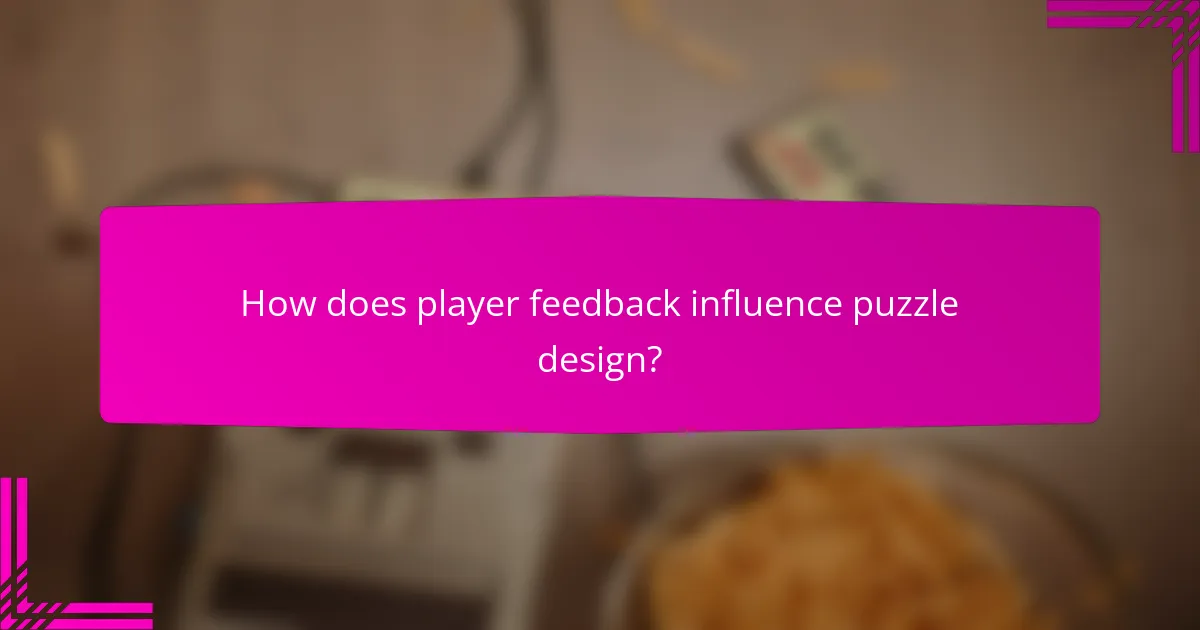
How does player feedback influence puzzle design?
Player feedback significantly shapes puzzle design by informing developers on player preferences and challenges. This feedback helps refine mechanics, enhance engagement, and improve overall gameplay experience. By analyzing player responses, designers can identify which puzzles are too difficult or too easy, adjusting difficulty levels accordingly. Additionally, player suggestions often inspire innovative mechanics, leading to unique puzzle solutions that enhance creativity and enjoyment. Regularly incorporating this feedback fosters a more satisfying and immersive gaming environment, ultimately resulting in higher player retention and satisfaction.
What methods can developers use to gather player insights?
Developers can gather player insights through surveys, analytics tools, user testing, and community feedback. Each method provides unique data on player preferences, behaviors, and challenges. Surveys collect direct player opinions, while analytics tools track in-game actions. User testing reveals gameplay challenges in real-time, and community feedback fosters engagement and deeper understanding of player needs.
How can iterative testing improve puzzle complexity?
Iterative testing enhances puzzle complexity by allowing designers to refine mechanics based on player feedback. This process identifies which elements challenge players effectively and which may frustrate them, leading to a balanced difficulty curve.
Through repeated cycles of testing and adjustment, designers can introduce unique attributes such as innovative mechanics that keep gameplay engaging. For instance, testing can reveal how different puzzle configurations impact player engagement and satisfaction.
Additionally, iterative testing enables the exploration of rare attributes, such as unconventional solutions or unexpected interactions, which can elevate the overall puzzle experience. Engaging players in this way fosters creativity and encourages exploration within the game’s mechanics.
Ultimately, iterative testing serves as a crucial tool for enhancing the depth and richness of portal puzzle design, ensuring that challenges remain both stimulating and enjoyable.
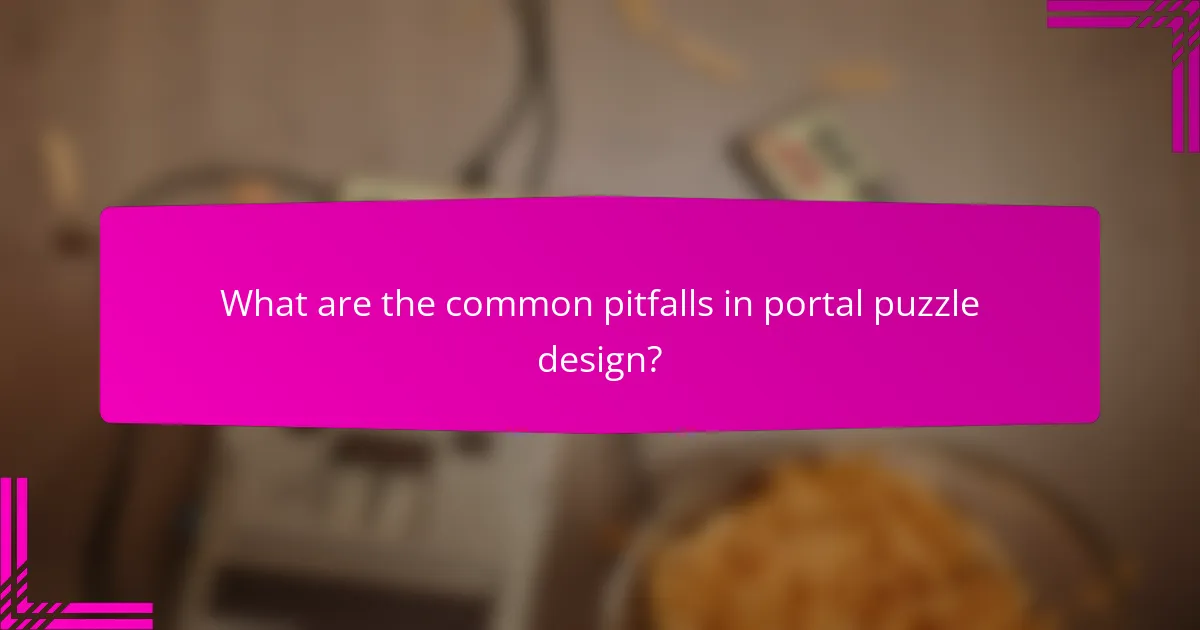
What are the common pitfalls in portal puzzle design?
Common pitfalls in portal puzzle design include overly complex mechanics, lack of clear objectives, and insufficient player guidance. These issues can frustrate players and hinder gameplay experience.
Complex mechanics may confuse players, leading to disengagement. Clear objectives are essential for maintaining player motivation; without them, players may feel lost. Insufficient guidance can result in players missing critical interactions, diminishing the puzzle’s impact.
Effective portal puzzle design requires balancing challenge and clarity to enhance player engagement and satisfaction.
How can over-complexity hinder player experience?
Over-complexity can significantly hinder player experience by creating confusion and frustration. When puzzle mechanics become overly intricate, players may struggle to understand objectives or how to progress. This can lead to disengagement and a diminished sense of accomplishment. Additionally, excessive complexity can obscure innovative gameplay elements, preventing players from fully appreciating the design’s creativity. Balancing challenge with clarity is essential for maintaining an enjoyable experience in portal puzzle design.
What mistakes should be avoided in level progression?
Avoid common mistakes in level progression by ensuring clarity, balancing difficulty, and maintaining player engagement.
1. Lack of clear objectives can confuse players and hinder progress.
2. Overly difficult challenges may frustrate players and lead to disengagement.
3. Inconsistent mechanics can disrupt the flow and learning curve.
4. Neglecting feedback can prevent players from understanding their performance.
5. Poor pacing can result in either overwhelming or underwhelming experiences.
6. Ignoring player creativity limits exploration and innovative solutions.
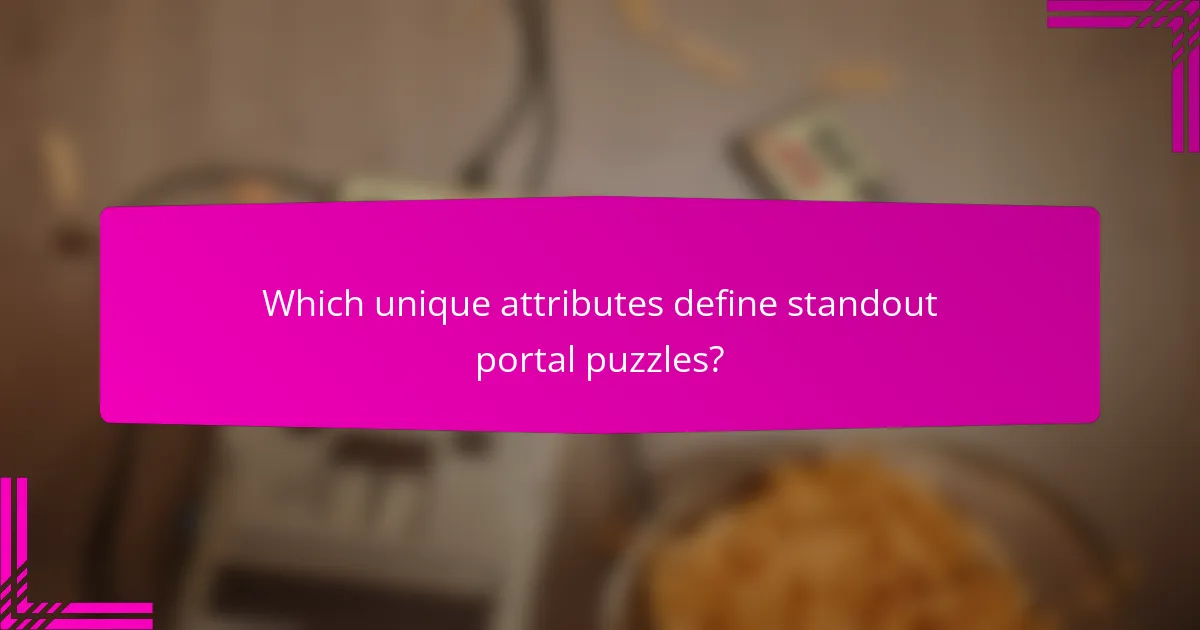
Which unique attributes define standout portal puzzles?
Unique attributes that define standout portal puzzles include innovative mechanics, spatial reasoning challenges, and engaging narrative integration. These features enhance gameplay by encouraging creative problem-solving and exploration. Unique mechanics often involve the manipulation of portals in unexpected ways, creating complex interactions. Additionally, the integration of narrative elements can deepen player immersion, making the puzzle-solving experience more compelling.
What narrative elements can enhance puzzle immersion?
Engaging narrative elements enhance puzzle immersion by creating emotional connections and deepening player investment. Strong storytelling, atmospheric sound design, and character development draw players into the game world. Incorporating environmental storytelling and visual cues helps convey context and enriches the gameplay experience. Unique mechanics that align with the narrative can also provide memorable moments, reinforcing the player’s journey through the puzzles.
How can visual aesthetics contribute to puzzle uniqueness?
Visual aesthetics significantly enhance puzzle uniqueness by creating immersive experiences. Unique designs, colors, and themes differentiate puzzles, attracting players. Aesthetic elements, such as intricate artwork and engaging animations, contribute to emotional engagement, making puzzles memorable. Additionally, visually distinct mechanics can introduce novel challenges, further enriching gameplay.
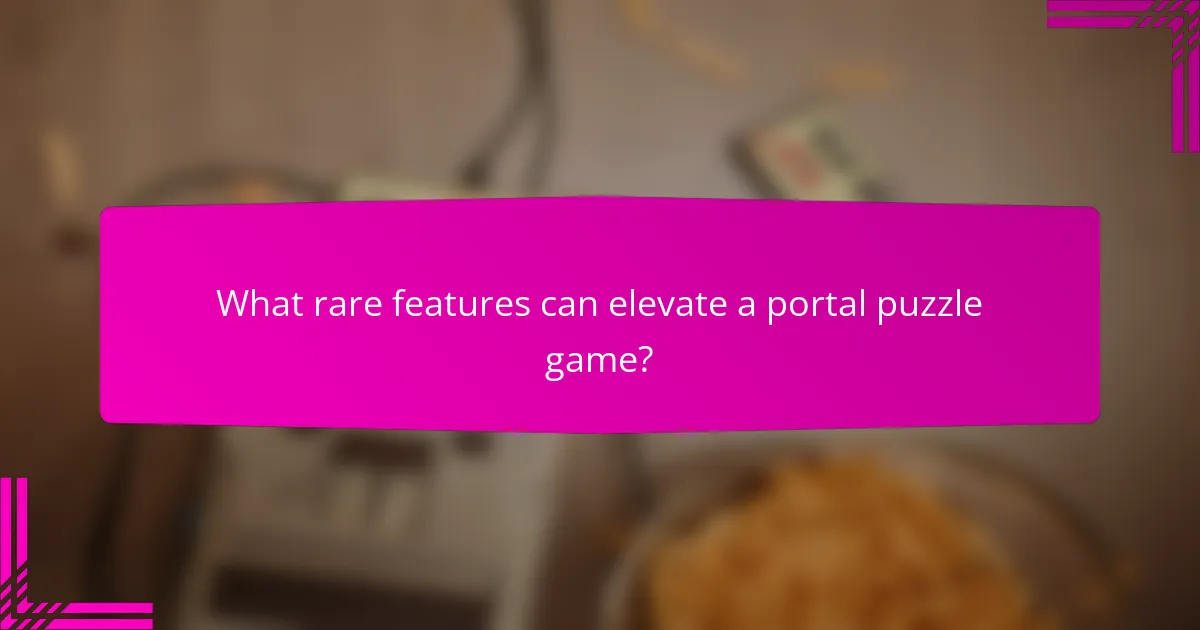
What rare features can elevate a portal puzzle game?
Unique features that can elevate a portal puzzle game include dynamic environmental changes, multi-dimensional puzzles, and AI-driven adaptive challenges. These elements enhance player engagement and encourage creative problem-solving. Dynamic environments can shift in real-time, altering puzzle mechanics. Multi-dimensional puzzles allow players to navigate through various planes, increasing complexity. AI-driven challenges adapt to player skill levels, ensuring a tailored experience.
How do cross-platform functionalities impact player interaction?
Cross-platform functionalities enhance player interaction by enabling seamless gameplay across different devices. This integration fosters a larger gaming community and improves accessibility. Players can engage with friends regardless of their platform, leading to increased collaboration and competition. Additionally, cross-platform mechanics can introduce unique challenges tailored to diverse control schemes, enriching the overall gameplay experience.
What innovative technologies are emerging in puzzle design?
Innovative technologies in puzzle design focus on immersive experiences and interactive mechanics. These include augmented reality, which overlays digital elements onto the physical world, enhancing engagement. Another emerging technology is procedural generation, creating unique puzzles dynamically, ensuring no two experiences are alike. Artificial intelligence is also being integrated, allowing for adaptive challenges that respond to player behavior, increasing replayability. Finally, haptic feedback technology adds a tactile dimension, making puzzle-solving more intuitive and satisfying.
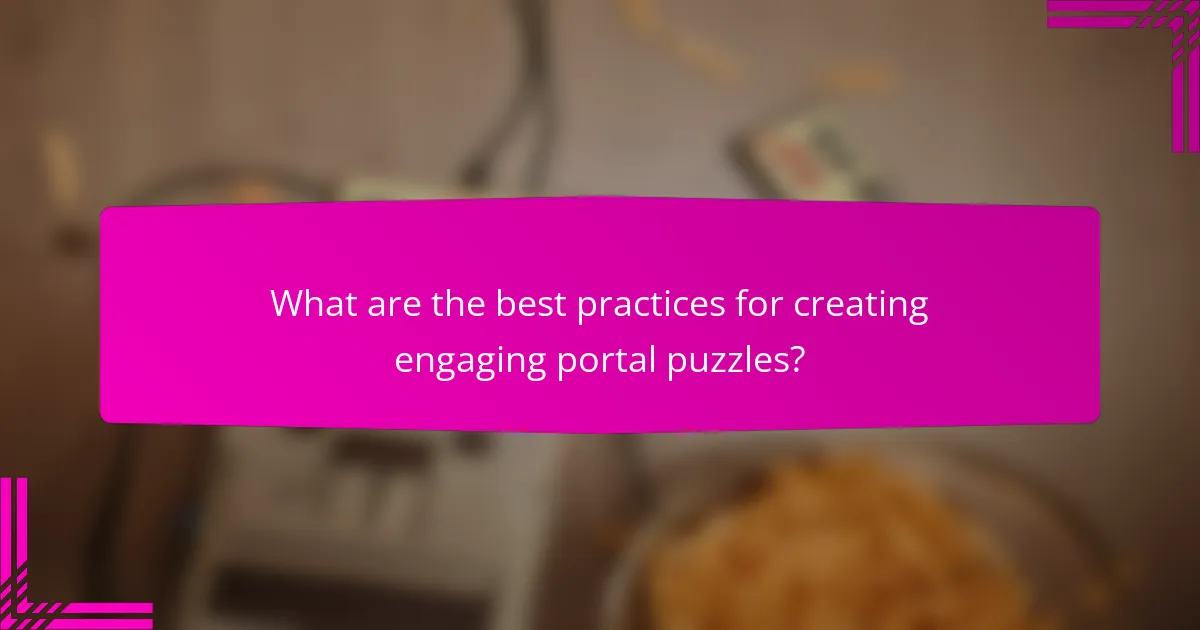
What are the best practices for creating engaging portal puzzles?
To create engaging portal puzzles, focus on innovative mechanics, diverse challenges, and immersive gameplay. Incorporate unique elements that surprise players and enhance problem-solving experiences.
1. Design puzzles with varying difficulty levels to cater to different player skills.
2. Utilize creative mechanics, such as teleportation and environmental interactions, to keep gameplay fresh.
3. Ensure clear visual cues and feedback to guide players without revealing solutions outright.
4. Integrate narrative elements that connect puzzles to the overall game story, enhancing player investment.
How can developers balance challenge and accessibility?
Developers can balance challenge and accessibility by designing puzzles that cater to diverse skill levels. Utilizing progressive difficulty, they can introduce mechanics that gradually increase complexity while providing hints or alternative solutions. This approach maintains engagement without alienating players. Incorporating feedback from playtests ensures that challenges are enjoyable and not frustrating. By prioritising user experience, developers create a more inclusive gameplay environment.
What strategies can be used to foster community-driven content?
To foster community-driven content, engage users through collaboration, feedback, and shared experiences. Implementing user-generated challenges enhances interaction and creativity. Encouraging players to submit their own puzzles can lead to innovative mechanics. Regularly featuring community creations builds a sense of ownership and loyalty.
